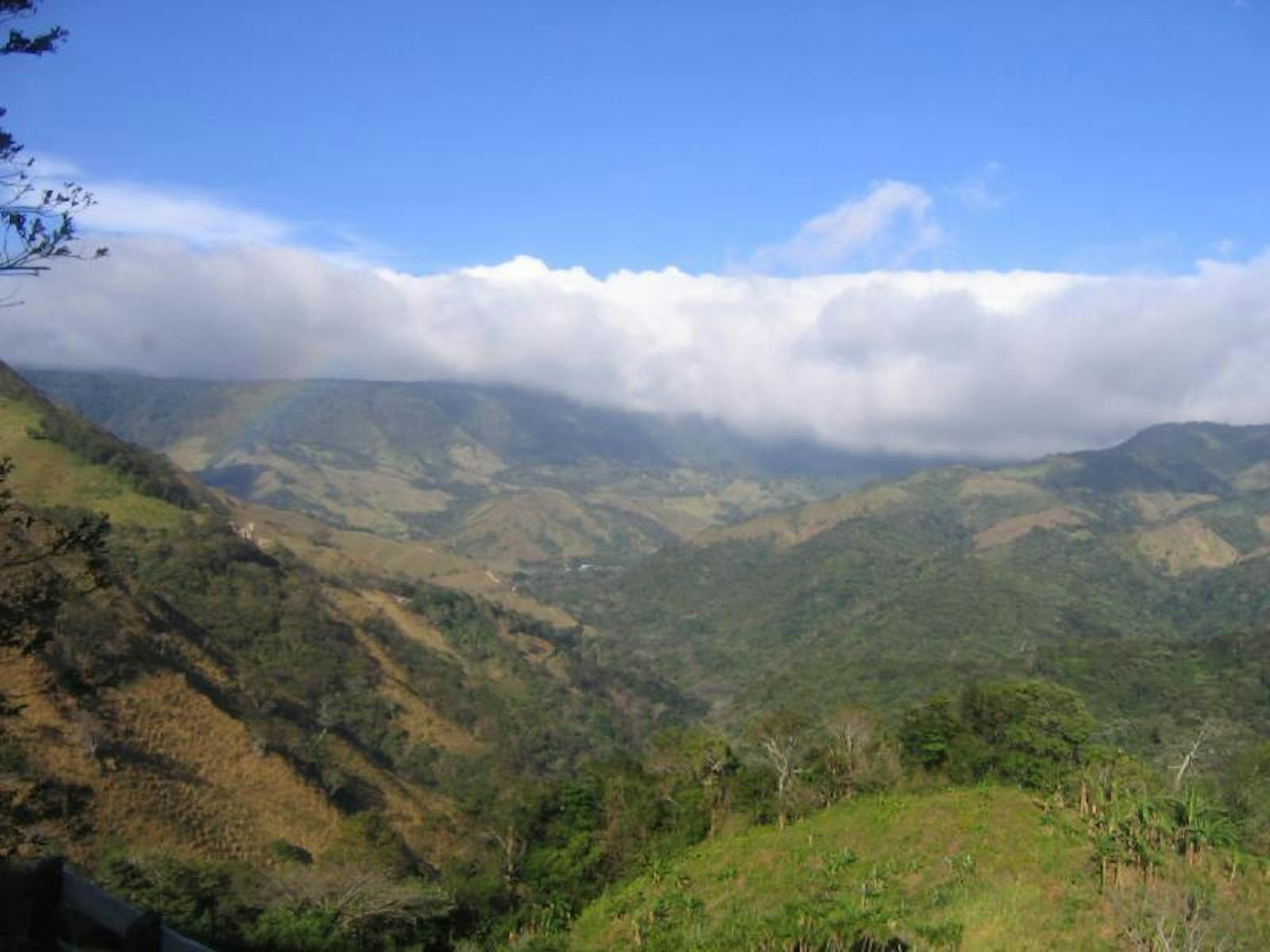Costa Rican Seasonal Moist Forests
The ecoregion’s land area is provided in units of 1,000 hectares. The protection goal is the Global Safety Net (GSN1) area for the given ecoregion. The protection level indicates the percentage of the GSN goal that is currently protected on a scale of 0-10.
Bioregion: Central American Mixed Forests (NT25)
Realm: Central America
Ecoregion Size (1000 ha):
1,072
Ecoregion ID:
458
Conservation Target:
55%
Protection Level:
2
States: Costa Rica, Nicaragua
The three-wattled bellbird typically breeds in foothill and highland moist forests but is known to migrate annually in Costa Rica into the Seasonal Moist Forest ecoregion. This tendency is called elevational or altitudinal migration and is a result of following the fruiting seasons of its favourite tree species (related to avocados).
The three-wattled bellbird is named after the male’s distinctive three black “wattles” that hang from the bill, which contrast sharply to its white nape and chestnut-brown belly and wings. The female on the other hand looks nothing like the male, being olive coloured with yellow streaks. Bellbirds are completely frugivorous and play an important role dispersing seeds along their elevational migrations.
The Costa Rican Seasonal Moist Forests ecoregion is a transitional subtropical habitat between the surrounding wet and dry forest ecoregions. The forests are dominated primarily by deciduous trees and associated communities, which lose their leaves during the distinct dry season. This relatively small ecoregion lies on the Pacific Slope, spanning the borders of northwestern Costa Rica and Nicaragua, between the crests of Costa Rica's central chain of volcanoes in the East and the Pacific Ocean in the West. For about five months, usually November through March, the ecoregion receives little to no rain. During the rest of the year approximately 225 mm falls monthly, comprising around 90% of the 1,500 mm of annual precipitation.
.jpg)
The flagship species of the Costa Rican Seasonal Moist Forests ecoregion is the three-wattled bellbird. Image credit: Csanchezj7, Creative Commons
The flora of this ecoregion exhibits high levels of beta diversity, meaning that species composition between different locations within the region varies significantly. The ecoregion falls in the dry-wet transitional zone and its landscape reflects as such, allowing different species to thrive in a variety of climate elements. Also, the adjacent mountain tops are typically wet cloud forest and often species of invertebrate and bird will migrate seasonally into the ecoregion. T
he resplendent quetzal and the three-wattled bellbird both migrate annually into the Costa Rican Seasonal Moist Forest ecoregion at the end of their breeding seasons. This allows them to take advantage of the delayed fruiting cycles of trees within the ecoregion, primarily of the Lauraceae family, many of which are endemic.
Additionally, many species from the dry forests of the Guanacaste region to the west rely on these forests as both a seasonal refuge and migration corridor. Many of the larger mammals are able to move back and forth from wet to dry habitats as seasonal changes shift food availability. This includes jaguar, ocelot, collared peccary, red brocket deer, and tapir among others.
The Costa Rican Seasonal Moist Forests have been extensively altered by human intervention. Lowland areas have been cleared for cattle, while mountain slopes, regardless of their steepness, have been cleared to grow beans, corn, coffee, as well as to support dairy cattle; most of Costa Rica's population and a significant portion of Nicaragua's lives within this ecoregion. During the past 100 years, virtually the entire ecoregion has been stripped of its native vegetation, with only small forest fragments remaining, totalLing less than 11% of the ecoregion's original forest cover.
In the past decade, there has been substantial regeneration of lower-elevation hillside habitats following the collapse of Costa Rica's cattle industry due to rising labour costs and decreasing yields after soils gave out from annual burning, over grazing, and resulting erosion. However, above 800 m, the situation remains critical as a growing human population puts ever-increasing demands for living space and agricultural products that grow well in the moderate mid-elevation climate.
The priority conservation actions for the next decade will be to: 1) encourage natural resource based management of the agriculture and cattle industry; 2) increase the number of and connectivity of protected areas to provide movement corridors between lowland and highland forests for wildlife; and 3) begin restoration projects in degraded habitats.
Citations
1. Powell, G. Palminteri, S. Schipper, J. 2019. Central America: Western Costa Rica. https://www.worldwildlife.org/ecoregions/nt0119 Accessed January 15, 2019.
2. Powell, G.V.N., and R.D. Bjork. 1994. Implications of altitudinal migration for conservation strategies to protect tropical biodiversity: a case study of the Resplendent Quetzal Pharomacrus mocinno at Monteverde, Costa Rica. Bird Conservation International (4).
3. Coen, E. 1983. Climate. In D. H. Janzen (editor), Costa Rican Natural History. University of Chicago Press, Chicago.
4. BirdLife International 2016. Procnias tricarunculatus. The IUCN Red List of Threatened Species 2016: e.T22700946A93806341. http://dx.doi.org/10.2305/IUCN.UK.2016 3.RLTS.T22700946A93806341.en. Accessed January 15, 2019.



